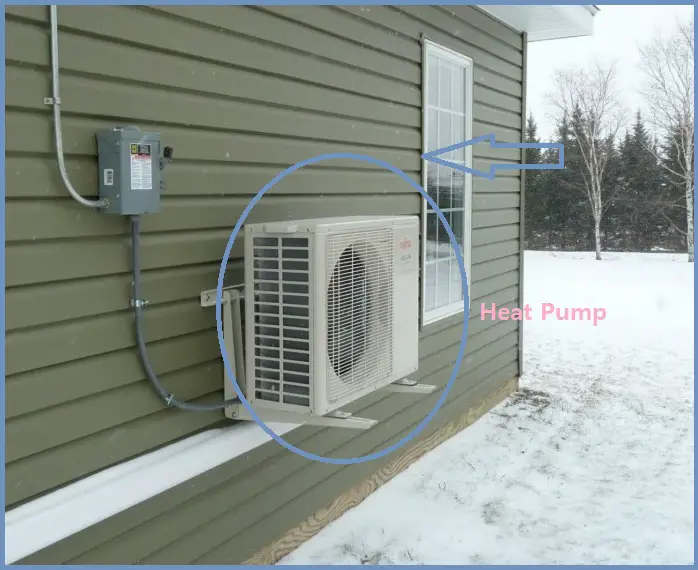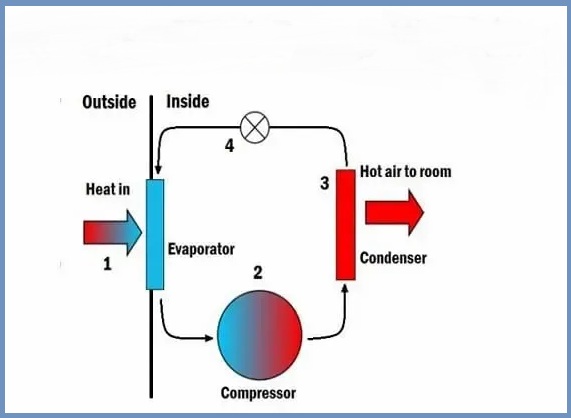A heat pump is a mechanical device that transfers heat energy between spaces, usually between closed spaces and the exterior atmosphere. When heating a building, energy is transmitted from the outside atmosphere to the building. The heat pump also functions as an air conditioner by transferring heat from the building to the outside.

The process of a heat pump is the same as the refrigeration cycle. In heating mode, the refrigerant is compressed at the outside air temperature. As a result, the refrigerant becomes hot. This thermal energy can be transferred to a central heating system. After being moved outdoor again, the refrigerant is decompressed. It has lost some of its thermal energy and returns colder than the environment. It can now take up the surrounding energy from the air or from the ground before the process repeats. Compressors, propellers, and pumps are powered by electrical energy.
Common types are air heat pumps, ground heat source heat pumps, water heat pumps, and exhaust heat pumps. They are also used in district heating systems. The efficiency of the heat pump is expressed as the coefficient of performance (COP) or the seasonal coefficient of performance (SCOP). The higher the number, the more efficient the heat pump and the less energy it uses. When it comes to space heating, heat pumps are usually much more energy-efficient than simple electrical resistance heaters.
The heat pump can play an important role in electrification, energy conversion, and climate protection due to its high efficiency and increasing proportion of fossil-free sources in the grid. With 1 kWh of power, 3-6 kWh of heat energy can be transferred to the building. The amount of carbon dioxide emitted by a heat pump depends on how electricity is generated. Heat pumps can meet 90% of the world’s heating needs with lower carbon dioxide emissions than gas-fired condensing boilers.
Table of Contents
How does a Heat Pump work?
A heat pump is an electric device that sends heat from a low-temperature region to a high-temperature region. The heat pump operates on the principle of heat transfer.
The heat pump works as follows:

First, the liquid refrigerant is transferred to the indoor coil via the expansion device. This inner coil acts as an evaporator. As the air in a house or other building passes through the coil, the refrigerant draws heat from the air and lowers the temperature. This cooled air blows through the ducts in the room to cool the room. When the refrigerant absorbs heat from the air, the temperature of the refrigerant rises and becomes a gaseous refrigerant. When the liquid refrigerant changes to a gaseous refrigerant, it is sent to the compressor. The compressor compresses the gaseous refrigerant. This makes the temperature and pressure of the gas very high.
After the compression process, the compressed gaseous refrigerant is supplied to the outdoor coil. These outdoor coils act as condenser coils, lowering the temperature of the compressed gas and returning it to the liquid refrigerant. There is an external fan to transfer the outside air (ie, the atmosphere) to the outside coil. The air in or around the house is cooler than the temperature of the compressed gas. Therefore, the heat of the compressed gas refrigerant is transferred to the outside air through the outdoor coil.
After heat transfer, the gaseous refrigerant turns into a liquid. This liquid refrigerant is sent from the outdoor coil to the expansion valve for further processing. When the hot liquid refrigerant enters the expansion valve, the refrigerant expands and the pressure drops. This process quickly converts the hot liquid refrigerant into a cold liquid refrigerant. As the refrigerant cools, it is pumped back to the indoor coil and the entire cycle is repeated.
How does a Reverse Heat Pump work?
The reverse heat pump operates in a heating circuit. This pump is installed in heated rooms and buildings. In the heating circuit, a pump extracts heat from the environment and carries it to the room.
The heating circuit works as follows.

First, a liquid refrigerant is introduced into the outdoor coil to extract heat from the outdoor air. Due to the heat transfer process, the temperature of the refrigerant rises and becomes a gaseous refrigerant. The gaseous refrigerant is introduced into the compressor where it is compressed. Due to the compression process, the pressure and temperature of the gaseous refrigerant will be very high.
Hot gas is sent to an indoor coil that acts as a condenser coil. These coils extract heat from the hot gas and transfer that heat to the room. This heat transfer process raises the temperature inside the room and makes it hot.
After this process, the refrigerant enters the expansion valve, where it cools and turns into a liquid. After this process, the liquid refrigerant is sent back to the outdoor coil and the entire cycle is repeated.
Types of Heat Pumps
- Air source pump
- Solar-assisted pump
- Geothermal heat pump
- Water source pump
- Exhaust air pump
- Hybrid pump
- Ductless pump
Pros
- These are electric pumps.
- Heat pumps have low running costs.
- Less maintenance.
- This pump has a long life.
- Provides excellent security.
- Reduces carbon emissions.
- The heat pump has two functions that are it both cools and heats the room as needed.
Cons
- Installation of these pumps is complicated.
- Prepaid costs will be higher.
- They cause problems in cold weather.
- These pumps do not have excellent sustainability.
Uses of Heat Pump
- Heat pumps are used in HVAC systems.
- They are used to warm the building.
- Reverse heat pumps are designed to cool different areas of residential and commercial buildings.
